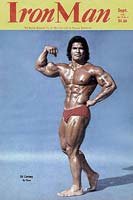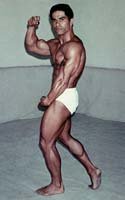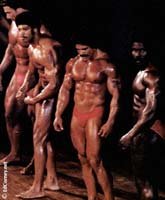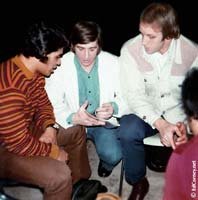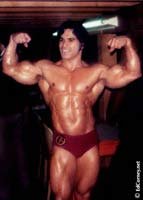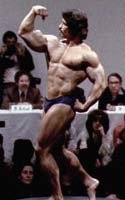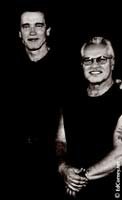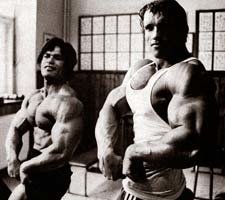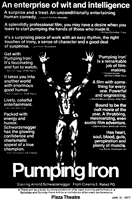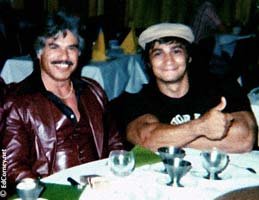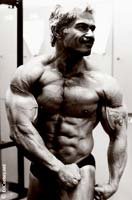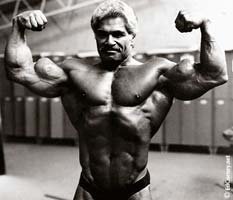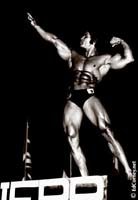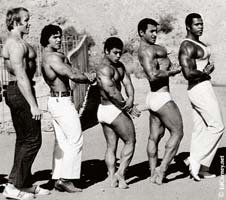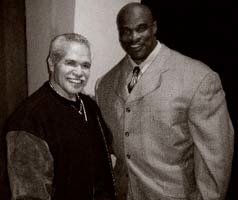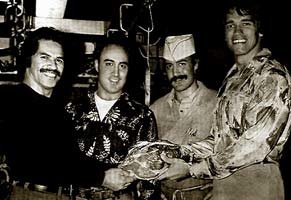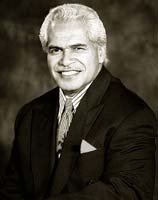It was forty years ago that bodybuilding great Ed Corney first tasted the victory he would become accustomed to throughout his career. Starting relatively late at age 33, Ed took home his first, first place trophy at The Mr. Fremont Championships. He eventually went on to win the 71 AAU Mr.California, 71 IFBB Mr.USA, and 72 IFBB Mr.America and Mr.Universe titles.
Today at over 70 years old, he still trains with a level of ferocity that many men half his age would admire. As one of the first men, among several notables including the great Arnold Schwarzenegger, to popularize bodybuilding in the 70's, Ed commands a special place in the sports history.
But even with so many champions from that era competing alongside him, Ed stood out in many ways. First of all there was the posing, an aspect of bodybuilding that Ed revolutionized - his onstage physical display was such that his routines from the 70's and early 80's are still spoken of today.
Simply put, Ed presented himself with a level professionalism that few in the sport have even come close to replicating and his transitions between poses and the impact of the poses themselves serve as inspiration for many today.
The popular 1976 bodybuilding film Pumping Iron captured Ed at his best, both as a master-poser and hardcore champion. Who could forget the scene where he and Arnold literally worked themselves to exhaustion at the squat rack?
Later in the film, the glimpse we caught of Ed posing at the 1975 Mr.Olympia prejudging showed just how flawless his posing really was. "Now that is what I call posing," Arnold commented throughout this display.
That same year Ed displayed his magnificent posing and physique alongside Arnold and Olympian in waiting, Frank Zane, in the Articulate Muscle exhibition at The Whitney Museum of American Art, a bodybuilding first that has not been done since.
Here Ed told all in attendance of his underlying motivation for developing his physique:
-
"I look at myself as a piece of art. I have taken 20 years to develop my physical body into the shape it's in right now, and if that isn't art, I don't know what art is."
In addition to his posing and onscreen popularity, Ed is famous for being one of the best short-class bodybuilders in the world, placing as high as 3rd overall in bodybuilding's biggest event, the Mr.Olympia.
The fact remains: his symmetry and size captured the interest of bodybuilding fans everywhere. Then there is his longevity. Not simply content to sit back and reflect on past glories, Ed has gone where few bodybuilding pioneers have gone: to achieve recognition as the best over-60 bodybuilder in the world through wins at both the 94 and 95 Masters Mr.Olympia.
It would be fair to say that Ed is the longest competing bodybuilder the world has seen and, although no longer competing (his last show was the 1998 Master's Arnold Classic, where he placed 10th) he shows no signs of slowing down on the training front.
In 2004 Ed was inducted into the IFBB Hall of Fame, an honor strictly reserved for those who have reached the highest levels within bodybuilding. Indeed, as a bodybuilding legend Ed has worked hard for his special place in history and may he continue to lift for many years to come.
In the following rare interview, Ed tells of his bodybuilding history and shares the stories of a life committed to the iron.

[ Q ] Hi Ed. You have been involved in competitive bodybuilding since 1967, the year you competed in your first show. What is it about bodybuilding that has kept you in the game for so long?
My first contest in 1967, honestly, was a fluke. My good friend Bob Perata organized a show for the members of his gym, where all of my buddies and I were working out. It took some convincing, but finally I relented and went onstage in my Speedos and took home that first place trophy.
I can't say that I would ever have considered competitive bodybuilding if it weren't for Bob's insistence that I take part in that first contest. Why didn't I stop at that first Mr. Fremont win? Well, I found the sport to be a perfect combination of physical, spiritual and mental challenge.
I guess you could say I fell in love with it. You have to remember that I didn't do that first show until I was almost 34 years old. Immediately following my win, and actually for much of the rest of my career, I heard things like, "Ed, you're too old to be on stage," "You are over the hill," "It's too late for you and you'll never amount to anything in this sport."
While I can't say that it was this kind of talk that motivated me to pursue excellence, it sure helped propel my own inner journey towards being the champion that I became.

[ Q ] You began bodybuilding relatively late, at age 33. What were you involved in - both sports and business-wise - prior to your bodybuilding career? Were you athletic as a youngster?
As a boy in Hawaii I was a natural at volleyball, body and board surfing and outrigger canoe paddling. However, I never really participated in a lot of the other team sports. At age fourteen I was introduced to Judo.
A friend suggested that I come down to the Dojo where he was studying. I took to it immediately and within four years earned my black belt. The discipline and focus that I needed in order to excel at Martial Arts came to serve me very well later on in my bodybuilding career.
My work life before becoming a professional bodybuilder consisted mainly of jobs that were related to the skills that I had acquired during my stint with the US Coast Guard. I was an aviation radio mechanic at Oakland airport in the late 1950s when I first began to train with weights at a local gym.

[ Q ] How did you get started in bodybuilding training?
During that period that I was working at the airport in the late 50's, I rekindled my childhood love of Volleyball and joined a local team composed entirely of Hawaiian transplants like me.
One fateful day my fellow Islanders and I challenged a team that was composed completely of bodybuilders. We figured, "Sure, they're big but I bet they're clumsy and slow. We'll kick their butts without breaking a sweat." How wrong we were. One of the players on the bodybuilder's team was a young Millard Williamson.
After the game I introduced myself to him. "I've never seen muscle like yours," I said. "Did you get them from training with weights?" "That's right," replied Williamson. "Weights are the fastest and most complete way of developing muscles ever devised."
I had always thought that weights would slow you down, but here I was standing next to one of the most muscular and talented volleyball players I had ever seen. He told me, "Weights don't slow you down. In fact, proper weight training and nutrition will make you faster and better coordinated."
In the weeks that followed I kept thinking about how much I would like to have a physique like Williamson's. With this goal in mind, I joined a local gym. I fumbled around a bit before I really learned any proper training methods, but even so, I immediately began to see my great genetic potential begin to manifest itself.

[ Q ] And your potential became evident as worked your way to the highest levels. What are some of your fondest recollections of the 70's, a time where you made your mark as one of the sports best?
There were so many great moments for me during that period in my career. Of course, there was the IFBB USA win, The IFBB Mr. America win, and the unbelievable experience that I had with my friend Mike Katz in Baghdad where, of course, I took the Mr. Universe title.
There was also the making of the Pumping Iron movie, my exhibition at the Whitney Museum in New York, the fantastic friendships and training partnerships that I formed with both Arnold and Danny Padilla, just to name a few.
Of course I can't ever forget the crowd support and enthusiasm that was given to me at the 1977 Olympia during my posing routine. Suffice it to say that the often-maligned decade of the 1970's was pretty darn good to me.

[ Q ] Tell me more about your involvement with Arnold and the gang at Gold's Gym? What was the atmosphere like back then?
I was living in Northern California after my USA, America and Universe victories. I received a phone call from Arnold inviting me to come and move down south to Santa Monica to live and train with him. I left the next day.
As we trained together during that period we were often being filmed for the Pumping Iron movie. It was actually Arnold's idea that I compete in my first Olympia (the 1975 South African show featured in the film).
As far as the Gold's Gym experience goes, I still remember it like it was yesterday. Certain things stand out in my mind: maximum intensity training as well as complete focus and determination. I can also still hear the sounds of weights rattling and being re-racked mixed with the noise of human exertion along with the smell of sweat.
All the greats were training there at that time - Waller, Zane, Katz, Grant, Columbu, Birdsong, Robby, Danny, Callard and so many more. It really was a once-in-a-lifetime, perfect moment in the sport.

[ Q ] Around this time, the book Pumping Iron was released to critical acclaim and you were the cover-man for this book. How did this opportunity come about and what did it mean for you?
Arnold and George Butler decided to put me on the cover. Arnold told me that it would be better to have my image defaced in the New York City subways when the posters went up for the book and movie.

[ Q ] On the cover and throughout this book and on the movie of the same title, your skills as a poser were showcased. Of course most bodybuilding fans know of you as probably bodybuilding's greatest poser. Exactly how did you become so good at presenting yourself onstage?
While serving in the US Coast Guard, dancing began to appeal to me. I was stationed near San Francisco in 1956 and began to frequent the jazz clubs and learn to love the sounds of Tito Puente, Cal Jayder, Mango Santa Maria and other Latin rhythm heroes.
It wasn't long before I discovered that I had a natural talent for Latin dance. I began showcasing my skills by performing in front of small audiences.
My clubbing in San Francisco was always done with a small click of friends, all of us serving in the Guard together. We soon became known by the quite unremarkable moniker, The Four Guys.
On a given night, the band would strike up a mambo; rumba or cha-cha and the four of us would jump onstage and show our moves to the appreciative crowd. Looking back now, this was my first experience of communicating with a wildly enthusiastic audience though movement.
By this time my older brother Joe was living right across the Bay from me in the city of Alameda. He was a ballroom dance instructor at the Arthur Murray School. I turned to him for instruction, not in the ballroom dance he was employed to teach, but rather in the complex moves of swing dancing. I found I was a real natural at the swing style of dancing as well.
Now, I could strut my stuff at both the Latin and Swing clubs all around the Bay Area. I entered quite a few dance contests during that time. These were the first competitions where I was judged on my movement. I just didn't have to strip to my underwear in order to compete. That would come ten years later.

[ Q ] Describe the training program you used back in the 70's? How did you train back then?
We did a six-day-a-week double split. We always used heavy weights for about eight to ten reps and we hit each body part twice a week. We did no cardio whatsoever back then. I worked abs before each and every workout. That means abdominal work twice daily because of the double split.

[ Q ] What inspired you to successfully build, and display your physique? 
A huge motivator for me was the opportunity for self-expression and communication with an audience that the sport provided me with. That's why I put such a huge emphasis on my posing. Neither the judges nor the audience watch you train, diet and prepare for the contest.
The moment of connection, the real moment of "truth", comes when you hit the stage. That was my time to both display my physical achievement and to express myself from the heart, not unlike a musician or dancer might do at a concert or recital.

[ Q ] Though self-expression and communication with an audience motivated you to compete, what has been your greatest bodybuilding moment and why?
The Masters Olympia 60+ win was a very sweet moment for me. The chance to get back onstage and do what I do best in front of such a gracious and appreciative crowd was unforgettable.

[ Q ] History will show that you won this event twice (in 94 and 95). What prompted you to compete once again?
Both Wayne Demilia and Joe Weider contacted me about the creation of a Masters Olympia event. They had seen some photographs that I posed for at age sixty and were impressed by the condition that I was able to achieve at that age. I accepted their invitation without hesitation.

[ Q ] At 60-plus, you looked amazing. How did you achieve this kind of size and conditioning at an age where many would struggle to even walk onto the stage?
I was training and eating the exact same way as I always had. The only difference was that some guy named Padilla had convinced me in the mid 1980's to get on a treadmill now and then.

[ Q ] You say you trained the same way for the Masters Olympia's as you did when you were at your peak. Did you not make any changes to accommodate the aging process?
For the most part, I train the same way now as I did when I was 33-years-old. The only changes that I've made are the addition, as I mentioned before, of cardio into my routine and the elimination of certain types of pressing motions that are now made difficult by my shoulder replacement.
I now employ a lot of pulling motions where before I might have used a pressing motion. I also tend to work with dumbbells in situations where, in the past, I would have used a barbell.

[ Q ] Based on your many years of involvement, what have you learned about bodybuilding? In your opinion, are there any training methods or dietary practices that work better than others?
Wow, I could probably write a book about that. In fact I am. But to keep it simple, I would sum it up by saying that the most effective training for me has always been focused, heavy and intense. I don't really take sides on the high intensity vs. volume debate. I just train heavy and hard.
| RELATED ARTICLE | ||
|
The dietary practice that I've found most useful is to concentrate my carbohydrate intake into the early part of each day and focus on protein intake during the latter part of the day.

[ Q ] How would you compare the 70's bodybuilding scene to that of today? How, in your view, has the sport changed?
Physiques have simply gotten more incredible. The bar (pardon the pun) continues to be raised. The sport is far less fringe and much more mainstream now. There are a hundred supplement companies now for every one that used to exist.
But really, when all is said and done, it still takes the same exact elements to create a champion now as it did 30 years ago - great genetics, laser-like focus, intensity in training, discipline in diet and practice in presentation. The myth that drugs can create a winner is just that, a myth.

[ Q ] How has bodybuilding benefited you?
What can I say? It's been my whole life since I walked onto that Mr. Fremont stage in 1967. Benefit? You be the judge.

[ Q ] What is your involvement in bodybuilding today? Do you still train?
I'm very involved with the sport. I do a lot of public appearances. I'm doing a bit of one-on-one personal training as well as workout, contest prep, posing and nutritional consultation by correspondence with a lot of today's athletes.
My web site has been a huge success and I'm enjoying all of the contact that it brings with old friends, family and fans from around the world. I also just released my first posing DVD and the response has been extremely gratifying.
As far as training goes, I'm in the gym seven days a week scaring the staff and other gym members with my poundages and intensity. I think a few of them probably have 9-1-1 already dialled on their cell phones.

[ Q ] You recent pictures suggest this training is working well for you. Who has been influential in your life and why?
Well, of course, there's Bob Perata, the man that first pushed me onto the stage in my underwear in 1967 at his Mr. Fremont show. I also owe so much to all of my family. My children and my grandchildren have been a constant source of strength, love and support throughout what has often been a very hectic career.
I also have to mention my long-suffering training partner, James Mendoza. He has not only been a great ally in the gym but also the best friend a guy could have through thick and thin. Oh yeah, I forgot, what's his name? That guy who's the Governor now? Without him and that little fellow from Rochester named Padilla, so much of what I have achieved in this sport would never have been possible.

[ Q ] Thank you for this interview, Ed. You are truly one of bodybuilding's legends. How would you describe your life in bodybuilding?
He came, he posed, he conquered.

[ Q ] What legacy would you like to leave the bodybuilding world?
I just want my stone to read, "I told you I wasn't feeling well."

